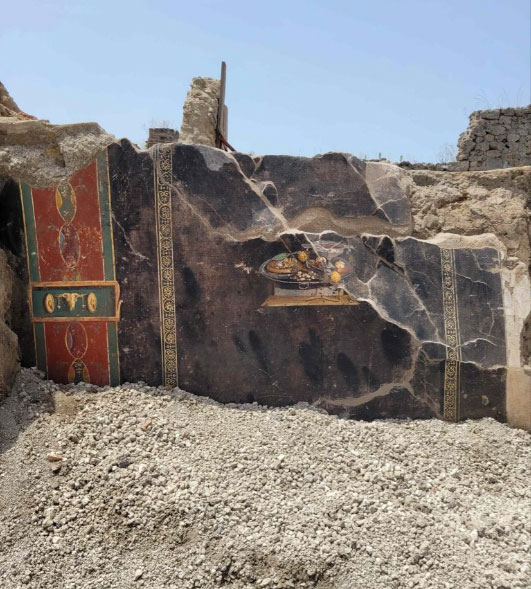NAPLES – It seems to be a pizza, the picture in a fresco that came to light in Pompeii, in a house in Regio IX.
What makes it unlikely is that 2,000 years ago, the raw materials to make a pizza, like tomatoes and mozzarella cheese, were missing.
Indeed, the image could evoke an ancestor of one of the most delicious and beloved food. As a matter of fact, Pizza was elevated to World Heritage status in 2017 as the “traditional art of the Neapolitan pizzaiuolo.”
A kind of flatbread appears in the fresco: archaeologists explain it could have been seasoned with spices or, perhaps, with a type of pesto (moretum in Latin). However, it also had the function of supporting various fruits, identifiable in pomegranates and dates.

“From the Vesuvian cities – reminds us a note from the Ministry of Culture – about three hundred of these depictions are known, with no timely comparison for the recently discovered fresco, which is also striking for its remarkable quality of execution, among the attestations found so far”.
Pompeii Archaeological Park Director, Gabriel Zuchtriegel explains: “In this fresco, we find some themes from the Hellenistic tradition, later elaborated by authors of the Roman-Imperial period such as Virgil, Martial and Philostratus. The contrast between a frugal and simple meal, on the one hand, and the luxury of silver trays and the refinement of artistic and literary representations, on the other. In this regard, how can we not think of pizza, which originated as a ‘poor’ dish in southern Italy and has now conquered the world and is served even in starred restaurants.”
Also Coldiretti, the association representing and assisting Italian agriculture, comments on the news of this surprising discovery. It declared: “From the tables of Pompeii to those of today, in two thousand years, pizza has come to be worth 15 billion euros. It symbolises the success of the Mediterranean diet in the world, but also an authentic engine for tourism and culture. Nowadays, Pizza today represents an Italian treasure where culture and food have become – Coldiretti stresses – the main levers of tourist attraction, strategic for the revival of the economy and employment.”
Finally, Coldiretti reminds us that the ancestor of pizza was not the only staple of Pompeii’s tables. Among the most fashionable dishes, “there was garum, a brine made from fish fermented in the sun and preserved in salt used to season an infinite number of recipes. Among the cheap drinks, the most popular was pòsca, consisting of vinegar diluted in water, while bakers baked at least ten types of bread in the 35 ovens surveyed in the city.”
“As soon as they got up in the morning,” – Coldiretti explains – “Pompeians had a breakfast (jentaculum) of bread with garlic and cheese, or dates, eggs, honey and fruit. Sometimes they used to eat meat since breakfast was one of the two main meals of the day”.


